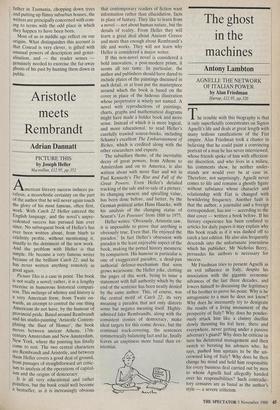Aristotle meets Rembrandt
Adrian Dannatt
PICTURE THIS by Joseph Heller
Macmillan, £12.95, pp.352
American literary success induces pa- ralysis, a masochistic certainty on the part of the author that he will never again touch the glory of his most famous, often first, work. With Catch 22 Heller entered the English language, and the novel's unpre- cedented success has pursued him ever since. No subsequent book of Heller's has ever been written about, from blurb to celebrity profile, without mentioning it, usually to the detriment of the new work. And the problem with Heller is that simple. He became a very famous writer because of the brilliant Catch 22, and he has never written anything remotely as good again.
Picture This is a case in point. The book is not really a novel; rather, it is a lengthy exercise in humorous historical compari- son. This melange of whimsy and history is a very American form, from Twain on- wards, an attempt to control the one thing Americans do not have, by the humour of provincial pride. Based around Rembrandt and his studio-painting 'Aristotle Contem- plating the Bust of Homer', the book moves between ancient Athens, 17th- century Amsterdam and New Amsterdam, New York, where the painting has finally come to Jest. The two central characters are Rembrandt and Aristotle, and between them Heller covers a good deal of ground, from passages of straightforward art critic- ism to analysis of the operations of capital- ism and the origins of democracy.
It is all very educational and rather Pointless, but the book could well become a bestseller, as it is increasingly obvious that contemporary readers of fiction want information rather than ellucidation, facts in place of fantasy. They like to learn from a novel — not about human nature, but the details of reality. From Heller they will learn a great deal about Ancient Greece and more than enough about Rembrandt's life and works. They will not learn why Heller is considered a major writer.
If this non-novel novel is considered a bold innovation, a post-modern prism, it seems all too tame. In particular, the author and publishers should have dared to include plates of the paintings discussed in such detail, or at least put the masterpiece around which the book is based on the cover in place of the hideous illustration whose perpetrator is wisely not named. A novel with reproductions of paintings, charts, graphs and mathematical diagrams might have made a bolder book and more sense. Instead of which it is more logical, and more educational, to read Heller's carefully trawled source-books, including Schama's excellent The Embarrassment of Riches, which is credited along with the other researchers and experts.
The subsidiary theme, of the inevitable decay of great powers, from Athens to Amsterdam and on to America, is also written about with more flair and wit in Paul Kennedy's The Rise and Fall of the Great Powers. Even Heller's detailed tracking of the sale and re-sale of a picture, its changing owners and spiralling value, has been done before, and better, by the German political artist Hans Haacke, with his analysis of the changing status of Seurat's 'Les Poseuses' from 1888 to 1975.
Heller writes: 'Obviously, Aristotle saw, it is impossible to prove that anything is obviously true. Even that. He enjoyed the paradox.' In fact Heller's obsession with paradox is the least enjoyable aspect of the book, making the potted history mesmeric by comparison. His humour in particular is one of exaggerated paradox, a dead-pan authorial defence-mechanism that soon grows wearisome, the Heller joke, clotting the pages of this work, being to issue a statement with full authority which by the end of the sentence has been neatly denied by the same author. This, of course, was the central motif of Catch 22, its very meaning a paradox that not only distorts sense but negates meaning itself. Highly- admired fake Rembrandts, along with the consistent ironies of democracy, make ideal targets for this comic device, but the continual track-covering, the sentences symmetrically balancing fact and lie, finally leaves an emptiness more banal than ex- istential.


































































 Previous page
Previous page